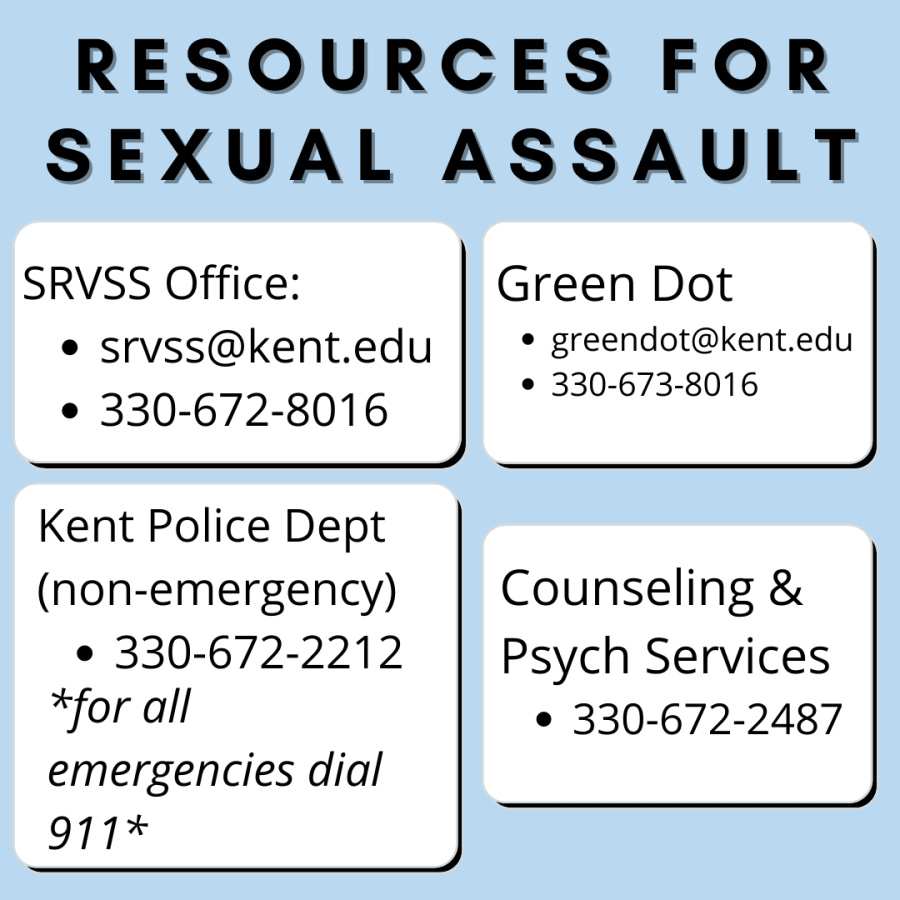Consensual sex (new head)
December 5, 2021
Trigger Warning: the following article mentions rape, sexual assault and sexual misconduct.
According to RAINN, 13 percent of all college students experience rape or sexual assault. Of undergraduate students, 26.4 percent of female college students and 8.6 percent of male students experience rape or sexual assault through physical force, violence or incapacitation.
Julius Payne, program coordinator at the Center for Sexual and Relationship Violence Support Services, said consensual vs. non-consensual sex is defined as “cut and dry” where if there’s any apprehension from either party, the situation is not consensual.
“Consensual sex is a mutual agreement to whatever sexual activity is going on,” Payne said. Non-consensual is the opposite, it’s when someone is moving your hands away when you’re trying to touch them … or they’re uneasy and they’re kind of tense.”
Prohibited sexual conduct at Kent State includes:
-
Rape:unlawful sexual activity and usually sexual intercourse carried out forcibly or under threat of injury against a person’s will or with a person who is beneath a certain age or incapable of valid consent because of mental illness, mental deficiency, intoxication, unconsciousness, or deception
-
Sodomy: oral or anal sexual intercourse with another person, without the consent of the victim
-
Sexual assault with an object: to use an object or instrument to unlawfully penetrate, however slightly, the genital or anal opening of the body of another person, without the consent of the victim
-
Fondling: the touching of the private body parts of another person for the purpose of sexual gratification without the consent of the victim
-
Incest: nonforcible sexual intercourse between persons who are related to each other within the degrees wherein marriage is prohibited by law
-
Statutory rape: nonforcible sexual intercourse with a person who is under the statutory age of consent
The SRVSS center “works to empower those affected by power-based personal violence and educates the community about healthy relationships and bystander activity.”
One of the programs SRVSS conducts is Green Dot training, a “see something, say something” approach to sexual assault.
“I would say internalize what’s going on, as far as put yourself in that person’s situation,” Payne said. “If you see something harmful, think about whether or not you would want somebody to help you.”
The next step involves thinking of a way to address the situation that is both comfortable for both parties: the person who experienced the sexual assault and the person reporting it.
“Sometimes … you’re not going to be comfortable just jumping in. But maybe you can let somebody know,” Payne said. “Or maybe after the situation dies down, you can check in with that potential victim to check in with the person who was being involved.”
SRVSS is a center based on resources, and making victims and bystanders knowledgeable on resources out there.
Payne said the center provides resources and support, but the rest is up to the individual. If someone visits the SRVSS on behalf of someone who experienced a sexual assault, that person will be given resources to be an ally and support system.
“One of the main things and most important things that we do is make sure that if someone comes to us as a friend of somebody or to support someone else, our focus is on that person coming to us,” Payne said. “[We’re] trying to help them and equip them with the resources to pass them on to their friend, or the tools to be a support system.”
While they let the person know their friend can come in, they want to focus on the person who came in so they can give them everything they can to be helpful and support the person in need.
“Just make sure that you listen — they may want to sit in silence, they may just need somewhere to go for that night or for that day, just hanging out,” Payne said. “We just want people to know that the best thing is to let them control what happens next, control where they go and what they do next, and then just be there for them.”
Payne said regardless of the place or time the incident occurred, the SRVSS office is always available.
It doesn’t matter when the sexual assault occurred, or when the harm occurred, it could have occurred when you were a kid,” Payne said. “We’re still a resource. Sometimes people feel like ‘well it didn’t happen here’ or ‘it didn’t happen in this past year,” — no. We’re a resource for people that have been victimized at any point in their lives.”
Kaitlyn Finchler is an assigning editor. Contact her at [email protected].





















